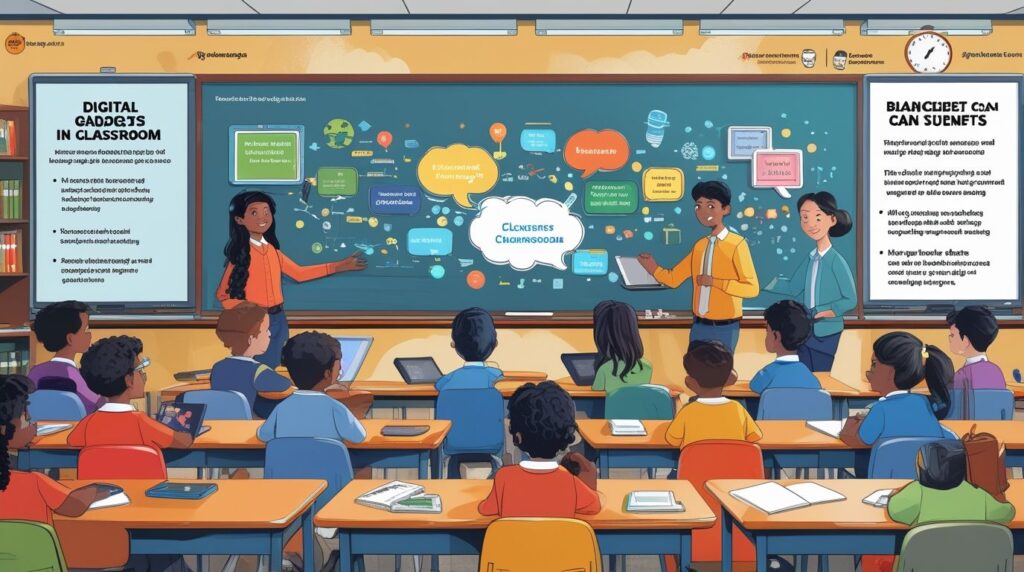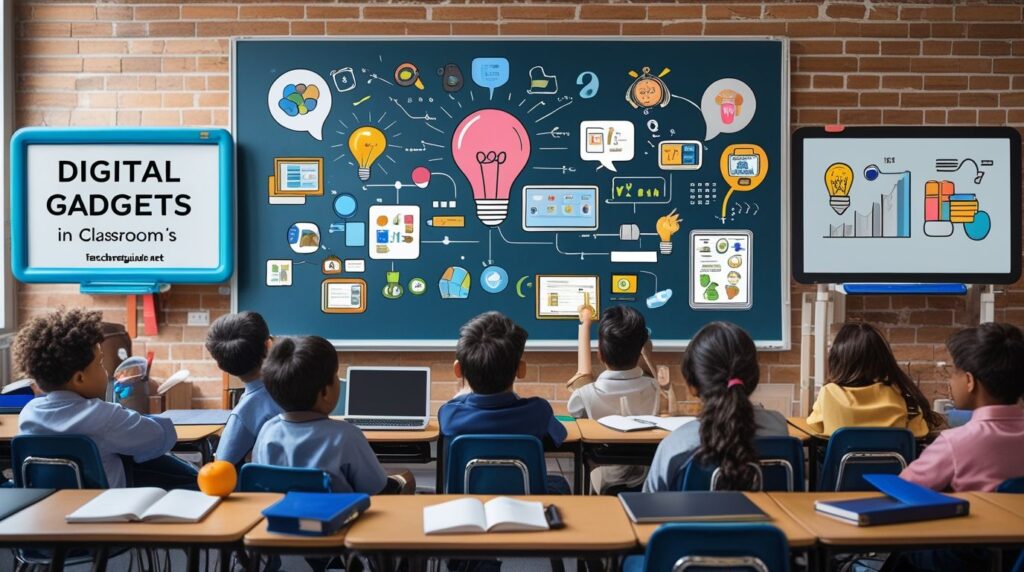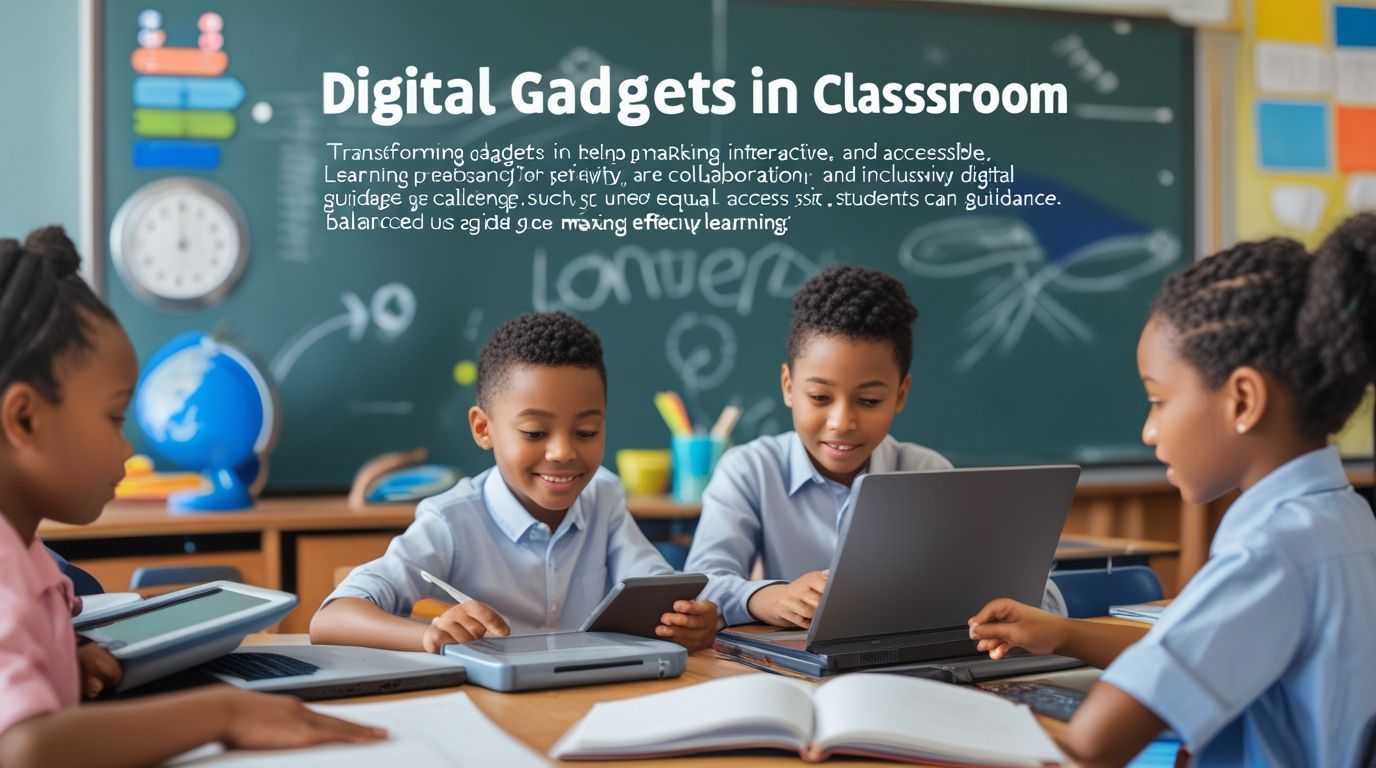Introduction to Digital Gadgets in Classroom
Digital Gadgets in Classroom, In the modern education system, digital gadgets in classroom have become an essential part of learning. They include laptops, tablets, projectors, smartboards, and even smartphones. These tools make teaching more interactive and keep students engaged in lessons. Moreover, they encourage students to explore beyond textbooks. With the rise of technology, classrooms are no longer limited to chalkboards and paper. Instead, learning is enhanced through multimedia and interactive tools. Therefore, schools around the world are investing in digital solutions. Teachers also benefit because they can present lessons more effectively. Additionally, students learn skills that prepare them for the digital era. However, the integration of digital gadgets requires thoughtful planning. Teachers must know how to balance technology with traditional learning methods. Hence, understanding the role of digital gadgets in classroom learning is very important today. Visit teachersguide.net for more insights.
Enhancing Learning Through Digital Tools
One of the main benefits of digital gadgets in classroom is their ability to enhance learning. For instance, smartboards make lessons more dynamic by combining visuals, sounds, and real-time interaction. Similarly, tablets and laptops give students access to a wide range of resources online. This access allows learners to research topics instantly and understand them in greater depth. Additionally, educational apps help students practice lessons at their own pace. Furthermore, video tutorials simplify complex subjects. Teachers also save time by using digital tools to present material more clearly. Moreover, digital gadgets allow teachers to track student performance effectively. This means that weak areas can be quickly identified and addressed. Although textbooks remain important, digital tools add a new dimension to learning. When used effectively, gadgets promote creativity and problem-solving. Thus, classrooms become spaces for innovation. Schools must therefore integrate digital gadgets in classroom strategies for better results.
Promoting Student Engagement
Engagement is a critical factor in education, and digital gadgets in classroom significantly improve it. Students are more motivated when lessons involve interactive activities. For example, quizzes on tablets or real-time polls on smartboards keep learners interested. Likewise, gamified applications turn boring subjects into exciting challenges. Additionally, group projects become easier with laptops and collaborative platforms. Through these tools, students learn teamwork while staying engaged. Moreover, gadgets provide instant feedback, which motivates learners to improve. Teachers can also personalize lessons based on student interest. This personalization makes students feel valued and keeps them attentive. Furthermore, digital gadgets often reduce classroom distractions because students are focused on meaningful tasks. However, teachers must monitor device usage to prevent misuse. When properly guided, students find learning enjoyable and memorable. Hence, digital gadgets in classroom settings play a crucial role in increasing student involvement. Explore more at teachersguide.net.

Supporting Inclusive Education
Digital gadgets in classroom also support inclusive education. Students with disabilities often struggle in traditional learning environments. However, digital tools help bridge this gap. For example, speech-to-text software assists learners with writing difficulties. Similarly, audio books help students with visual impairments. Tablets and laptops provide adjustable text sizes, ensuring everyone can follow along. Moreover, interactive tools help children with learning disabilities engage at their own pace. Teachers can also design customized lessons for different learning needs. Furthermore, gadgets promote equality by giving every student the chance to participate. Students from diverse backgrounds benefit from access to the same digital resources. This makes classrooms more inclusive and fair. Additionally, online platforms connect learners across the globe, expanding cultural understanding. Digital gadgets therefore create opportunities for all students to succeed. When technology is used inclusively, education becomes more meaningful. Hence, schools should ensure access to digital gadgets in classroom learning for every child.
Teacher’s Role in Using Gadgets
While technology is important, the teacher remains central in guiding students. Digital gadgets in classroom cannot replace teachers but can support them. Teachers must know how to use gadgets effectively to make lessons engaging. Training is essential because many teachers are not fully confident with new tools. Moreover, teachers should balance digital and traditional teaching to maintain focus. They must also ensure students use devices responsibly. For instance, limiting non-educational browsing during lessons is necessary. Teachers should select apps and tools that match learning objectives. Furthermore, monitoring progress with digital platforms allows them to adjust teaching methods. Another responsibility is to encourage collaboration among students using technology. Additionally, teachers need to create a safe digital environment to prevent misuse. With proper guidance, students gain more from gadgets. Thus, teachers play a critical role in maximizing the potential of digital gadgets in classroom learning. Learn more at teachersguide.net.
Advantages of Digital Gadgets in Classroom
The use of digital gadgets in classroom brings several advantages. Firstly, they make learning interactive and fun. Students find lessons interesting when visuals and sounds are included. Secondly, they promote independent learning. Learners can search for answers themselves and build critical thinking skills. Thirdly, they allow for easy access to vast resources online. This broadens the scope of education beyond textbooks. Fourthly, they improve communication between teachers and students. Through gadgets, teachers provide feedback more efficiently. Moreover, group projects become easier with online collaboration tools. Digital gadgets also save time because lessons can be prepared and delivered quickly. They also reduce paperwork, making classrooms more eco-friendly. Furthermore, students become more familiar with technology, which is vital for their future careers. Overall, the benefits of gadgets outweigh the challenges. Hence, schools must adopt them wisely. For deeper insights, visit teachersguide.net.

Challenges of Using Digital Gadgets
Although digital gadgets in classroom offer many benefits, they also come with challenges. One concern is distraction. Students may misuse devices for gaming or social media. Another issue is unequal access. Not all students can afford personal gadgets, creating gaps in learning. Additionally, constant exposure to screens may affect health, such as eyesight problems. Teachers may also face difficulties if they lack proper training. Furthermore, internet connectivity issues can disrupt lessons. Schools must invest in strong infrastructure to avoid such problems. Security is another concern since online platforms may expose students to harmful content. Moreover, over-reliance on technology may weaken basic skills like handwriting. Balancing digital and traditional methods is necessary to prevent such drawbacks. Despite these challenges, solutions can be found through careful planning. Therefore, while gadgets are powerful, they must be used with responsibility. Schools must establish rules for effective use of digital gadgets in classroom settings.
Future of Digital Gadgets in Education
Looking ahead, the future of digital gadgets in classroom is very promising. With advancements in artificial intelligence, classrooms will become even more personalized. Students will have access to virtual tutors and AI-driven feedback systems. Virtual and augmented reality will also change the way subjects are taught. For instance, history lessons may involve virtual tours of ancient cities. Similarly, science experiments can be performed in 3D simulations. Furthermore, digital gadgets will continue to make global learning possible. Students will connect with peers worldwide and share ideas. Teachers will also have smarter tools to track progress and improve teaching strategies. However, with these innovations, schools must prepare to address new challenges. Training, digital safety, and equitable access must remain priorities. Overall, the role of digital gadgets in classroom learning will grow stronger. Therefore, integrating them wisely will shape the education of tomorrow. Learn more at teachersguide.net.
Conclusion
In conclusion, digital gadgets in classroom are transforming the way students learn and teachers teach. They make education interactive, engaging, and inclusive. Although challenges like distraction and unequal access exist, careful planning can overcome them. Teachers play a central role in ensuring gadgets are used effectively. Moreover, the advantages of digital tools prepare students for a technology-driven future. As education evolves, digital gadgets will remain key to innovative learning. Schools must therefore embrace technology while balancing it with traditional teaching. By doing so, they can provide students with meaningful and future-ready education. To explore more educational topics, visit teachersguide.net.
References
- Mishra, P., & Koehler, M. J. (2006). Technological Pedagogical Content Knowledge: A Framework for Teacher Knowledge. Teachers College Record, 108(6), 1017-1054.
- Selwyn, N. (2016). Education and Technology: Key Issues and Debates. Bloomsbury Publishing.
- Voogt, J., Knezek, G., Cox, M., Knezek, D., & Brummelhuis, A. (2013). Under which conditions does ICT have a positive effect on teaching and learning? A Call to Action. Journal of Computer Assisted Learning, 29(1), 4-14.

jar3wd
scvygz